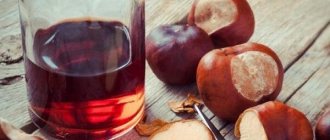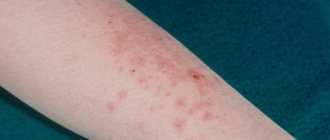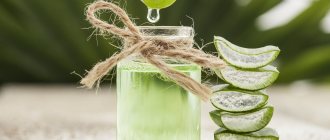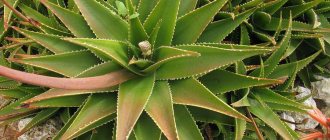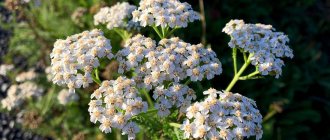Composition and release form
| Liquid | 100 ml |
| juice from biostimulated leaves or “children” of aloe vera | 80 ml |
| ethanol | 20 ml |
in dark glass bottles of 50 ml; 1 bottle in a cardboard pack.
| Syrup | 1000 g |
| freshly prepared 20% solution of ferrous chloride | 135 g |
| food grade citric acid | 4 g |
| diluted hydrochloric acid | 15 g |
| aloe vera syrup | up to 1000 g |
in dark glass bottles of 100 g; 1 bottle in a cardboard pack.
| Liniment | 1 ban. |
| Aloe vera juice | |
| Eucalyptus oil | |
| Castor oil | |
| excipients: emulsifiers |
in dark glass jars of 30 g; in a cardboard pack 1 jar.
| Film-coated tablets | 1 table |
| crushed preserved aloe vera leaf | 0.05 g |
in a blister pack 10 pcs.; 2 packs in a cardboard box.
Benefits of plant leaves
The benefits of aloe are easy to explain if you know the composition of the pulp of its leaves.
The plant contains about 200 biologically active substances, each of which has certain benefits.
Aloe contains:
- vitamins A, E, C;
- B vitamins;
- amino acids;
- polysaccharides;
- anthraquinone glycosides;
- resins;
- phytoncides;
- gelonins;
- enzymes, etc.
Aloe is known for its wound healing properties . In addition, the juice of the plant accelerates the process of restoration of the mucous membrane of the stomach and duodenum. Aloe also has anti-burn, analgesic, anti-inflammatory and antimicrobial properties. It has a detrimental effect on:
- fungi;
- staphylococci;
- streptococci;
- causative agents of dysentery and diphtheria.
In small doses, aloe juice improves appetite and digestion, in large doses it acts as a laxative. Indications for the use of plant juice are also colds, diseases of the mucous membranes, stomatitis and even tuberculosis.
We discuss the beneficial and medicinal properties of aloe in more detail in a separate material.
Pharmaceutical product
Pharmacy aloe is often confused with agave, which is grown at home. The difference between these plants is small, but still there. Agave is a type of pharmaceutical aloe (aloe vera). The main difference between these plants is their appearance. Aloe vera has long, pointed leaves that grow from the root upward. Agave grows in the form of a small tree with a trunk on which pointed leaves are located.
The leaves of indoor agave are much thinner and smaller than those of pharmaceutical aloe, so they contain little useful juice. But both agave and pharmaceutical aloe have almost the same beneficial properties.
For oral administration, it is aloe vera that is used, not agave.
pharmachologic effect
Pharmacological action - general tonic, adaptogenic.
Aloe juice enhances bile secretion, the secretion of digestive glands, has a laxative effect and bactericidal activity against pathogens (internally), anti-inflammatory, wound-healing effect (externally).
Aloe syrup with iron contains easily digestible iron for the formation of hemoglobin and normal hematopoiesis, replenishes the lack of iron in the body associated with poor absorption in the gastrointestinal tract, blood loss, malnutrition, increased need for iron (pregnancy, active growth in children and adolescents).
Aloe liniment accelerates epithelization, increases skin tolerance to X-ray irradiation, has an analgesic effect, reduces burning sensation and tightness. In experiments on rabbits, it was found that when used prophylactically, it reduces the reaction and significantly shortens the healing time of radiation damage to the skin.
Aloe coated tablets are used as a biogenic stimulant.
Contraindications and possible harm of traditional medicine
Since aloe juice is hypoallergenic, there are no contraindications to the external use of this flower. It must be used internally with care:
- This is especially true for pregnant women, women during lactation, people with unidentified diagnoses (we talked about whether the use of aloe during pregnancy is allowed here).
- You should not consume the juice of the plant during exacerbation of chronic diseases, serious illnesses and disorders of the nervous system (increased excitability, epilepsy).
- There is also no need to give high concentrations of plant juice to children under three years of age (more information on the use of aloe for children can be found in a separate publication).
Improper use of aloe at home can lead to side effects such as:
- dispersion;
- heartburn;
- discomfort and pain in the abdomen;
- loose stools;
- increased menstruation.
Less commonly, you may notice an increase in temperature and blood pressure, and a decrease in blood sugar levels.
To reduce the risk of side effects, aloe and its juice should be consumed at least two hours before bedtime.
Read about recipes for using aloe in traditional medicine, as well as contraindications, here.
Indications for the drug Aloe juice
Aloe juice: gastritis, gastroenteritis, enterocolitis, constipation (including spastic and atonic), chronic colitis (inside); acute and chronic purulent diseases (externally).
Aloe syrup with iron: anemia of various origins, iron deficiency in the body due to malabsorption, blood loss, malnutrition, increased need for iron (pregnancy, active growth of children and adolescents).
Aloe liniment: second and third degree burns, prevention and treatment of skin lesions during radiation therapy, dry and moist epidermatitis, kraurosis of the vulva, acute and subacute inflammatory processes (dermatitis, eczema, psoriasis, neurodermatitis, lichen planus) and other skin diseases.
Aloe coated tablets: myopic chorioretinitis, in the complex treatment of progressive myopia.
Aloe vera uses
16. Another rather unusual property of aloe
is that its juice can lighten small darkened areas of the skin.
17. Using aloe, you can prepare
an organic sugar scrub
that will rejuvenate your skin without aggressive effects on it. To prepare the scrub, you need to mix 2 tablespoons of aloe juice, 2 tablespoons of natural brown sugar and one teaspoon of natural lemon juice.
18.
For a more fashionable effect on large areas of the skin,
you can prepare a scrub based on aloe vera juice and sea salt. It's not difficult to prepare.
To do this, you will need two glasses of sea salt, a glass of aloe juice, a glass of natural coconut oil and two tablespoons of honey. It is better to buy honey not in a store, but directly from trusted people.
19. Using aloe juice, you can
have a beneficial effect on hair growth
and accelerate it. So, if your hair grows slowly and you've tried everything available, aloe vera juice may be your savior.
It must be used as follows:
rub aloe juice into the hair roots, leave in this state for 30 minutes and rinse thoroughly with clean water.
20. Additionally, in some cases, aloe juice can help you
get rid of dandruff
. For best results, mix the juice with coconut milk and wheat germ oil. After mixing, massage the resulting mixture into your scalp. After this, rinse with clean water.
Read: 10 houseplants that release oxygen even at night
Directions for use and doses
Aloe juice: orally, 20–30 minutes before meals, 1 teaspoon 2–3 times a day; externally - in the form of lotions and direct irrigation of wounds. Course - 15–30 days.
Aloe syrup with iron: orally, 1/2–1 teaspoon in 1/4 glass of water for 1 dose. Course - 15–30 days.
Aloe liniment: externally, to prevent skin damage - after each irradiation, lubricate the skin with liniment throughout the course (on average 45 days); for treatment - apply a thin layer to the affected skin surface 2-3 times a day and cover with gauze; in gynecology - morning and evening applied to the affected areas 2 times a day (morning and evening); for acute and subacute inflammatory processes of the skin - apply a thick layer to the affected areas (without subsequent application of a bandage) 2 times a day; for dry skin, lubricate the affected areas of the skin with liniment alternate with lanolin.
Aloe coated tablets: orally, 15 minutes before meals, 1 tablet. 3–4 times a day. The course is 1 month, if necessary, repeat after 3–6 months.
Recipe for aloe tincture with honey
Ingredients
- vodka/diluted alcohol (40-45°) - 500 ml;
- aloe leaves - 500 g;
- honey - 500 g.
Cooking technology:
- Wash aloe leaves well in cold water. Then dry on paper towels.
- Afterwards, the leaves must be finely chopped, honey and alcohol added.
- Shake well, cover with gauze and let it brew in a cool, dark place for two months.
- Cover the finished tincture with a lid and store in the refrigerator in a dark container.
Helpful tips before use
- What leaves are suitable? Choose an agave
that is about three years old. - To prevent diseases, it is enough to drink one tablespoon of tincture before meals.
- Use a high-quality alcohol base, otherwise the taste and aroma may be greatly affected.
- Do not drink the tincture after 7 pm: the drug can cause insomnia.
- Do not use the drink if you have an individual intolerance to the components: leaves, ethyl alcohol.
- You should not use the tincture for the following diseases: kidney failure, hepatitis, hypertension, exacerbation of cystitis and hemorrhoids.
Useful properties of tincture
- The plant has beneficial properties and is an antiseptic, so it will help with colds.
- Drinking the tincture helps reduce skin rashes and restore facial firmness.
- The drink will also help with disorders of the intestines and other organs of the digestive tract.
- The tincture will help with acute respiratory viral infections and acute respiratory infections.
- Rinsing your mouth with tincture will help get rid of the unpleasant odor.
- The drink helps increase appetite and absorption of nutrients.
- Drinking the tincture improves immunity and body tone.
- The tincture normalizes the functioning of the visual organ due to the high content of vitamins A and E.
- The tincture is effective in combating headaches.
- Experts recommend using it for women with painful menstruation.
Conclusion
We can conclude that aloe is an excellent healer for various diseases. In addition, the leaves of this plant can be found in every apartment.
Be sure to try making a healing and tasty aloe tincture, just don’t forget to choose a high-quality alcohol base. It can be vodka or homemade rectified alcohol. And if questions may arise about the quality of vodka, then rectified alcohol is a different story. This is an absolutely clean and environmentally friendly product, which you can also prepare yourself at home, using only high-quality and environmentally friendly ingredients.
If quality is the most important thing for you, check out our online store. In the catalog you will find modern moonshine stills that will help you easily obtain a high-quality alcohol base for aloe tincture. Happy experimenting!
Read comments (6) or comment
Aloe vera medicinal properties
21. Aloe can
make your hair silky and soft
as well as any conditioner.
22. Aloe vera juice can replace unnatural makeup removers.
If you are on bad terms with the latter, natural aloe juice
will definitely not harm your skin
, because it does not contain any special additives.
23. Boil the leaves in a saucepan and gently inhale the steam.
- This is a kind of inhalation for a beneficial effect on breathing. If you have problems with it, such inhalations will not harm.
24. To make your teeth and gums healthy
, you can chew small pieces or rinse your mouth with aloe juice.
If you don't have this plant at home, you can use an aloe-based mouthwash or toothpaste. Such products will definitely strengthen and improve your gums and teeth
.
